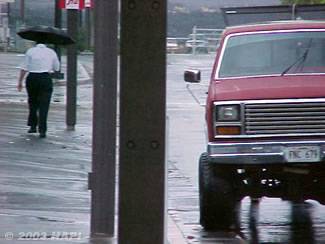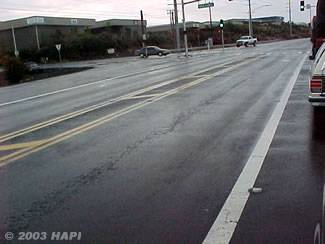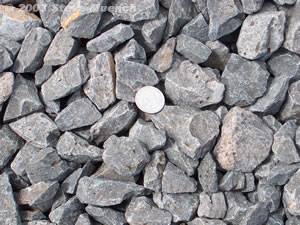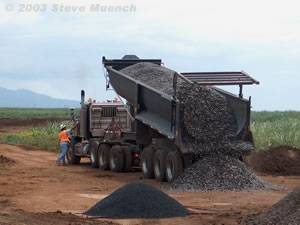Drainage
Proper drainage is important to ensure a high quality long lived pavement; moisture accumulation in any pavement structural layer can cause problems. Moisture in the subgrade and aggregate base layer can weaken these materials by increasing pore pressure and reducing the materials' resistance to shear. Additionally, some soils expand when moist, causing differential heaving (the roadway heaves up as the underlying soil expands). Moisture in the HMA layers can cause stripping because it, instead of the asphalt binder, will adhere to aggregate particles.
 |
 |
| Figure 1: Pavement Drainage in Action | Figure 2: A Rarity - Rain in Kona |
Moisture sources are typically rainwater, runoff and high groundwater. These sources are prevented from entering the pavement structure or accumulating in the subgrade through surface drainage and subsurface drainage. Usually, it is more cost effective and less risky to prevent moisture entry and accumulation using surface drainage than to remove moisture using subsurface drainage.
Surface Drainage
Surface drainage is concerned with removing all water that is present on the pavement surface, shoulder surface or any other surface from which it may flow onto the pavement. If not systematically removed, this water can accumulate underneath and weaken the pavement structure. There are three primary means used to prevent water infiltration and accumulation:
- Impermeable HMA. HMA tends to be impermeable below about 8 percent air voids, therefore proper compaction practices should be followed to ensure an impermeable pavement. Also, minor cracks in the HMA should be promptly sealed.
- Slope. The pavement section should be sloped to allow rainwater to sheet flow quickly to the edge where it is typically collected in a curb and gutter system or a roadside ditch. A generally accepted standard is a 2 percent cross slope.
- Grade. The curb and gutter or roadside ditch must be properly graded to allow flow to central collection points such as catch basins or detention ponds. A generally accepted standard is a grade of 0.5 percent or more although lesser grades have been used effectively.
Subsurface Drainage
Subsurface drainage is concerned with removing water that percolates through or is contained in the underlying subgrade. This water, typically the result of a high water table or exceptionally wet weather, can accumulate under the pavement structure by two chief means:
- Gravity flow. Water from surrounding areas can be absorbed by the soil then flow by gravity to areas underneath the pavement structure. In pavement with high air voids (above 8 - 9 percent), water can percolate down through the pavement structure itself.
- Capillary rise. Capillary rise is the rise in a liquid above the level of zero pressure due to a net upward force produced by the attraction of the water molecules to a solid surface (e.g., soil). Capillary rise can be substantial, up to 20 ft. or more. In general, the smaller the soil grain size, the greater the potential for capillary rise. Often, capillary rise is a problem in areas of high groundwater tables.
Most pavements have performed adequately without considering these effects. However, HMA pavements can fail because of subgrade support deterioration as a result of excessive moisture or other water-related problems. These issues can be addressed in two manners:
- Minimize water infiltration into the pavement structure. In most cases, the accumulated water in the underlying subgrade that causes the damage comes from surface infiltration. This infiltration can be minimized by providing proper roadside drainage and minimizing air voids within the HMA.
- Provide subsurface drainage. This needs to be done judiciously,
because it may be somewhat akin to treating the symptom
rather than the problem. Subsurface drainage consists
of three basic
elements (see Figure 4):
- A permeable base to provide for rapid removal of water which enters the pavement structure. Based on recent research from California, permeable base layers may strip and become clogged with fines thus weakening the overall pavement structure. If unbound, they may also be less stable than a dense-graded aggregate.
- A method of conveying the removed water away from the pavement structure. At the least, this may consist of a base sloped towards a drainage ditch. At the most, this may consist of a pipe collector system.
- A filter layer (such as a geotextile, graded aggregate layer or ACB) to prevent the migration of fines into the permeable base from the subgrade, subbase or shoulder base material. Excess fines in the permeable base will clog its drainage routes and render it ineffective. Depending upon the subgrade and pavement structure a filter layer may not be used.

Figure 4: Subsurface Drainage Example
| HAPI Pavement Note on Permeable Base Course | ||||||||||
Unbound dense-graded aggregate is a commonly used base course material in Hawai'i. HDOT also specifies an untreated permeable base course, which is an open-graded aggregate with a 2-inch maximum aggregate size (nominal maximum aggregate size of between 2 inches and 1.5 inches).
|






